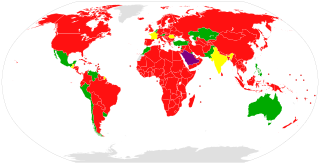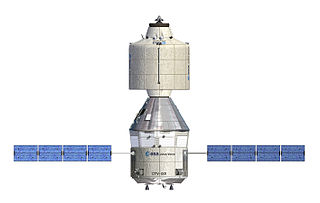The space program of the People's Republic of China is directed by the China National Space Administration (CNSA). Its technological roots can be traced back to the late 1950s, when China began a ballistic missile program in response to perceived American threats. However, the first Chinese crewed space program only began several decades later, when an accelerated program of technological development culminated in Yang Liwei's successful 2003 flight aboard Shenzhou 5. This achievement made China the third country to independently send humans into space. Plans currently include a permanent Chinese space station in 2020 and crewed expeditions to the Moon.
China National Space Administration (CNSA) is the national space agency of China. It is responsible for the national space program and for planning and development of space activities. CNSA and China Aerospace Corporation (CASC) assumed the authority over space development efforts previously held by the Ministry of Aerospace Industry. It is a subordinate agency of the State Administration for Science, Technology and Industry for National Defence (SASTIND), itself a subordinate agency of the Ministry of Industry and Information Technology (MIIT).

The Discovery Program is a series of Solar System exploration missions funded by the US National Aeronautics and Space Administration (NASA) through its Planetary Missions Program Office. Each mission has a cost cap, at a lower level than a mission from NASA's New Frontiers or Flagship Programs. As a result, Discovery missions tend to be more focused on a specific scientific goal.

The Agreement Governing the Activities of States on the Moon and Other Celestial Bodies, better known as the Moon Treaty or Moon Agreement, is a multilateral treaty that turns jurisdiction of all celestial bodies over to the participant countries. Thus, all activities would conform to international law, including the United Nations Charter.
The Lunar and Planetary Institute (LPI) is a scientific research institute dedicated to study of the solar system, its formation, evolution, and current state. The Institute is part of the Universities Space Research Association (USRA) and is supported by the Science Mission Directorate of the National Aeronautics and Space Administration (NASA). Located at 3600 Bay Area Boulevard in Houston, Texas, the LPI maintains an extensive collection of lunar and planetary data, carries out education and public outreach programs, and offers meeting coordination and publishing services. The LPI sponsors and organizes several workshops and conferences throughout the year, including the Lunar and Planetary Science Conference (LPSC) held in March in the Houston area.

The Orlan space suit is a series of semi-rigid one-piece space suit models designed and built by NPP Zvezda. They have been used for spacewalks (EVAs) in the Russian space program, the successor to the Soviet space program, and by space programs of other countries, including NASA.

Crew Space Transportation System (CSTS), or Advanced Crew Transportation System (ACTS), is a proposed design for a crewed spacecraft for low Earth orbit operations such as servicing the International Space Station, but also capable of exploration of the Moon and beyond. It was originally a joint project between the European Space Agency (ESA) and the Roscosmos, but is now solely an ESA project. This study was conceived as a basic strategic plan to keep a viable European human spaceflight program alive because NASA officials had announced that their Orion spacecraft would be developed without participation of international partners.

The Chinese Lunar Exploration Program, also known as the Chang'e Project after the Chinese moon goddess Chang'e, is an ongoing series of robotic Moon missions by the China National Space Administration (CNSA). The program incorporates lunar orbiters, landers, rovers and sample return spacecraft, launched using Long March rockets. Launches and flights are monitored by a Telemetry, Tracking, and Command (TT&C) system, which uses 50-metre (160-foot) radio antennas in Beijing and 40-metre (130-foot) antennas in Kunming, Shanghai, and Ürümqi to form a 3,000-kilometre (1,900-mile) VLBI antenna. A proprietary ground application system is responsible for downlink data reception.

The following outline is provided as an overview of and topical guide to space exploration:
Several Asian countries have space programs and are actively competing to achieve scientific and technological advancements in space, a situation sometimes referred to as the Asian space race in the popular media as a reference to the earlier Space Race between the United States and the Soviet Union. Like the previous space race, issues involved in the current push to space include national security, which has spurred many countries to send artificial satellites as well as humans into Earth orbit and beyond. A number of Asian countries are seen as contenders in the ongoing race to be the pre-eminent power in space.
Chang'e 2 is a Chinese unmanned lunar probe that was launched on 1 October 2010. It was a follow-up to the Chang'e 1 lunar probe, which was launched in 2007. Chang'e 2 was part of the first phase of the Chinese Lunar Exploration Program, and conducted research from a 100-km-high lunar orbit in preparation for the December 2013 soft landing by the Chang'e 3 lander and rover. Chang'e 2 was similar in design to Chang'e 1, although it featured some technical improvements, including a more advanced onboard camera. Like its predecessor, the probe was named after Chang'e, an ancient Chinese moon goddess.

The Review of United States Human Space Flight Plans Committee was a group convened by NASA at the request of the Office of Science and Technology Policy (OSTP), to review the nation's human spaceflight plans to ensure "a vigorous and sustainable path to achieving its boldest aspirations in space." The review was announced by the OSTP on May 7, 2009. It covered human spaceflight options after the time NASA had planned to retire the Space Shuttle. A summary report was provided to the OSTP Director John Holdren, White House Office of Science and Technology Policy (OSTP), and NASA Administrator on September 8, 2009. The estimated cost associated with the review was expected to be US$3 million. The committee was scheduled to be active for 180 days; the report was released on October 22, 2009.

A lunar rover or Moon rover is a space exploration vehicle designed to move across the surface of the Moon. The Apollo Program's Lunar Roving Vehicle was driven on the Moon by members of three American crews, Apollo 15, 16, and 17. Other rovers have been partially or fully autonomous robots, such as the Soviet Union's Lunokhods and the Chinese Yutus. Three countries have had operating rovers on the Moon: the Soviet Union, the United States and China. Indian mission is en-route while Japan and Greece currently have planned missions.

The Algerian Space Agency, (ASAL) was established on January 16, 2002 in Bouzareah, Algiers. It is in charge of the Algerian space program. ASAL has flown five different satellites.
Chang'e 6 is a planned robotic Chinese lunar exploration mission expected to be launched in 2023 or 2024 and perform China's second sample return mission. Like its predecessors, the spacecraft is named after the Chinese moon goddess Chang'e.

Luna 26 (Luna-Resurs-Orbiter) is a planned lunar polar orbiter, part of the Luna-Glob program, by the Russian space agency Roscosmos. In addition to its scientific role, the Luna 26 orbiter would also function as a telecomm relay between Earth and Russian landed assets. This mission was announced in November 2014, and its launch is planned for 2024 on a Soyuz-2 rocket.
ZhengHe is a proposed asteroid sample-return and comet exploration mission by China.









